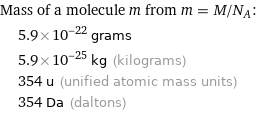Input interpretation

EDTA zinc salt | molar mass
Result
![Find the molar mass, M, for EDTA zinc salt: M = sum _iN_im_i Plan: • Write the chemical formula and gather atomic masses from the periodic table. • Determine values for N_i and m_i using these items. • Finally, compute the mass. Write the chemical formula: Zn[(O_2CCH_2)_2NCH_2CH_2N(CH_2CO_2)_2]-2 Use the chemical formula to count the number of atoms, N_i, for each element: | N_i C (carbon) | 10 H (hydrogen) | 12 N (nitrogen) | 2 O (oxygen) | 8 Zn (zinc) | 1 Look up the atomic mass, m_i, in g·mol^(-1) for each element in the periodic table: | N_i | m_i/g·mol^(-1) C (carbon) | 10 | 12.011 H (hydrogen) | 12 | 1.008 N (nitrogen) | 2 | 14.007 O (oxygen) | 8 | 15.999 Zn (zinc) | 1 | 65.38 Multiply N_i by m_i to compute the mass for each element. Then sum those values to compute the molar mass, M: Answer: | | | N_i | m_i/g·mol^(-1) | mass/g·mol^(-1) C (carbon) | 10 | 12.011 | 10 × 12.011 = 120.110 H (hydrogen) | 12 | 1.008 | 12 × 1.008 = 12.096 N (nitrogen) | 2 | 14.007 | 2 × 14.007 = 28.014 O (oxygen) | 8 | 15.999 | 8 × 15.999 = 127.992 Zn (zinc) | 1 | 65.38 | 1 × 65.38 = 65.38 M = 120.110 g/mol + 12.096 g/mol + 28.014 g/mol + 127.992 g/mol + 65.38 g/mol = 353.59 g/mol](../image_source/d3ae08bd6989b2e36c544842e8a1079e.png)
Find the molar mass, M, for EDTA zinc salt: M = sum _iN_im_i Plan: • Write the chemical formula and gather atomic masses from the periodic table. • Determine values for N_i and m_i using these items. • Finally, compute the mass. Write the chemical formula: Zn[(O_2CCH_2)_2NCH_2CH_2N(CH_2CO_2)_2]-2 Use the chemical formula to count the number of atoms, N_i, for each element: | N_i C (carbon) | 10 H (hydrogen) | 12 N (nitrogen) | 2 O (oxygen) | 8 Zn (zinc) | 1 Look up the atomic mass, m_i, in g·mol^(-1) for each element in the periodic table: | N_i | m_i/g·mol^(-1) C (carbon) | 10 | 12.011 H (hydrogen) | 12 | 1.008 N (nitrogen) | 2 | 14.007 O (oxygen) | 8 | 15.999 Zn (zinc) | 1 | 65.38 Multiply N_i by m_i to compute the mass for each element. Then sum those values to compute the molar mass, M: Answer: | | | N_i | m_i/g·mol^(-1) | mass/g·mol^(-1) C (carbon) | 10 | 12.011 | 10 × 12.011 = 120.110 H (hydrogen) | 12 | 1.008 | 12 × 1.008 = 12.096 N (nitrogen) | 2 | 14.007 | 2 × 14.007 = 28.014 O (oxygen) | 8 | 15.999 | 8 × 15.999 = 127.992 Zn (zinc) | 1 | 65.38 | 1 × 65.38 = 65.38 M = 120.110 g/mol + 12.096 g/mol + 28.014 g/mol + 127.992 g/mol + 65.38 g/mol = 353.59 g/mol
Unit conversion

0.3536 kg/mol (kilograms per mole)
Comparisons

≈ 0.49 × molar mass of fullerene ( ≈ 721 g/mol )

≈ 1.8 × molar mass of caffeine ( ≈ 194 g/mol )

≈ 6.1 × molar mass of sodium chloride ( ≈ 58 g/mol )
Corresponding quantities

Mass of a molecule m from m = M/N_A: | 5.9×10^-22 grams | 5.9×10^-25 kg (kilograms) | 354 u (unified atomic mass units) | 354 Da (daltons)

Relative molecular mass M_r from M_r = M_u/M: | 354